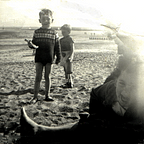Who was Rorschach?
…. a pioneering genius, bumbling dilettante, megalomaniac visionary, responsible scientist and just about everything in between… Damion Searls
Hermann Rorschach (1884–1922) invented what would become one of the most widely used personality assessment tools. The ‘ink blot test’ emerged from the Swiss psychiatrist’s passion for klecksography — turning inkblots into recognisable images. Influenced by the newly emerging field of psychoanalysis, Rorschach explored how emotion shapes perception.
Born into an an artistic family, Rorschach lost both his parents at an early age and was brought up by a cold and distant stepmother. At school he was prodigy — speaking several languages and excelling as an artist.
Despite, or perhaps because of, his academic brilliance, Rorschach was not an ivory tower man. At 19 he wrote to his sister: “I never again want to read just books, I want to read people … The most interesting thing in nature is the human soul, and the greatest thing a person can do is to heal these souls, sick souls.”
There were no undergraduate courses in the study of the ‘human soul’ so Hermann opted for medicine, specialising in psychiatry. Zurich was the right town for that. His teachers included Eugen Bleuler — who coined the terms schizophrenia and autism — and Carl Jung.
In 1910, Rorschach married a Russian medical school classmate, Olga Stempelin. The couple emigrated to Russia in 1913, but he returned to a within a year to become the director of the Herisau Asylum. Olga was initially detained in Russia but managed to rejoin her husband before the the chaos of 1917. They had two children.
Hermann Rorschach had seemingly emerged from the perils of war, revolution and the Spanish flu pandemic relatively unscathed. His academic postion was secure and his research was attracting international attention. He seemed set for a long illustrious career.
Then peritonitis struck. Little is known about the circumstances of his death. Given that he was medically trained and married to a doctor it has been assumed that there can have been little warning. This would tend to suggest a ruptured appendix.[11]
A year after Psychodiagnostik (1921) — the results of his studies on 300 mental patients and 100 others — Rorschach was dead. He was just 38.
The ink blot test emerged out of Rorschach’s work with patients with severe psychiatric disorders. He experimented with hundreds of blots before settling on ten that he felt offered the most insight into emotional states. These standard black or coloured inkblot designs became the basis of a test to assess personality traits and emotional tendencies.
From the 1940s use of the test spread into many other areas — as an element in occupational psychology for example. It is still used all over the world and is particularly popular in Japan. In a diluted form it has become short-hand for dividing people into personality types, something which sits uncomfortably with its ‘scientific’ claims. As Damion Searls puts it
today the Rorschach test is admissible in court, reimbursed by medical insurance companies and administered around the world in job evaluations, custody battles and psychiatric clinics. The common habit of describing Brexit or Beyoncé or anything else as “a Rorschach test”
Rorschach could not, of course, join the fierce controversy that would surround his work. His intention had been to provide insight into the mental processes involved with what was broadly termed schizophrenia. He had cautioned that ‘that the test is primarily an aid to clinical diagnosis’.
Initial interest in the scientific value of his work has morphed into accusations of quackery. As with Freudianism and other strands of psychotherapy, there are clear problems in applying the term ‘evidence’ to what appears to be subjective.
What survives is the metaphorical power of the concept. The Rorschach test, like the Oedipus Complex has entered the lexicon and the collective imagination. And what mere other scientist can claim to be voted the 16th most popular comic book character of all time Magazine?
